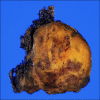Extra-adrenal pheochromocytoma after operation of congenital heart disease: a case report of 18-year-old boy
- PMID: 22792537
- PMCID: PMC3392319
- DOI: 10.4174/jkss.2012.83.1.65
Extra-adrenal pheochromocytoma after operation of congenital heart disease: a case report of 18-year-old boy
Abstract
Extra-adrenal pheochromocytoma is rare and presents variable symptoms. Its difficulty to diagnosis delays appropriate treatment. We would like to report an unusual case of extra-adrenal pheochromocytoma. The patient came to the emergency room with dyspnea, palpitation, and cyanosis. He had a history of hospitalization for Fontan operation due to congenital heart disease. Despite medication, his blood pressure remained high. After additional laboratory and image exams, he was diagnosed with extra-adrenal pheochromocytoma and had surgical treatment. The final pathology report was extra-adrenal pheochromocytoma with high risk of malignancy. The postoperative course was uneventful and showed normal laboratory results even after 3 months of outpatient follow-up. Extra-adrenal pheochromocytoma presents variable symptoms. We should consider endocrinologic diseases like extra-adrenal pheochromocytoma in cases presenting with palpitation and high blood pressure, even with a past history of cardiac surgery.
Keywords: Congenital heart defect; Fontan procedure; Paraganglioma; Pheochromocytoma.
Conflict of interest statement
No potential conflict of interest relevant to this article was reported.
Figures



Similar articles
-
Pheochromocytoma and paraganglioma in Fontan patients: Common more than expected.Congenit Heart Dis. 2018 Jul;13(4):608-616. doi: 10.1111/chd.12625. Epub 2018 Jul 22. Congenit Heart Dis. 2018. PMID: 30033572
-
Extra-adrenal pheochromocytoma with initial symptom of haemoptysis: a case report and review of literature.BMC Surg. 2021 Jan 6;21(1):13. doi: 10.1186/s12893-020-01038-6. BMC Surg. 2021. PMID: 33407379 Free PMC article. Review.
-
[A Case of Undiagnosed Extra-adrenal Pheochromocytoma in an Adult Patient with Single Ventricle Circulation after the Bidirectional Glenn Operation].Masui. 2015 Sep;64(9):985-8. Masui. 2015. PMID: 26466501 Japanese.
-
Use of desflurane during anesthesia for resection of extra-adrenal pheochromocytoma: a case report.JA Clin Rep. 2018 Oct 18;4(1):75. doi: 10.1186/s40981-018-0212-z. JA Clin Rep. 2018. PMID: 32025984 Free PMC article.
-
Pheochromocytoma and extra-adrenal paraganglioma: updates.Arch Pathol Lab Med. 2008 Aug;132(8):1272-84. doi: 10.5858/2008-132-1272-PAEPU. Arch Pathol Lab Med. 2008. PMID: 18684026 Review.
Cited by
-
Fontan Circulation Associated Organ Abnormalities Beyond the Heart, Lungs, Liver, and Gut: A Systematic Review.Front Cardiovasc Med. 2022 Mar 22;9:826096. doi: 10.3389/fcvm.2022.826096. eCollection 2022. Front Cardiovasc Med. 2022. PMID: 35391839 Free PMC article.
-
Pheochromocytoma and paraganglioma in cyanotic congenital heart disease.J Clin Endocrinol Metab. 2015 Apr;100(4):1325-34. doi: 10.1210/jc.2014-3863. Epub 2015 Jan 12. J Clin Endocrinol Metab. 2015. PMID: 25581599 Free PMC article.
-
Pheochromocytoma complicated by cyanotic congenital heart disease: a case report.Clin Pediatr Endocrinol. 2016 Apr;25(2):59-65. doi: 10.1297/cpe.25.59. Epub 2016 Apr 28. Clin Pediatr Endocrinol. 2016. PMID: 27212797 Free PMC article.
-
Catecholamine-Secreting Tumors in Pediatric Patients With Cyanotic Congenital Heart Disease.J Endocr Soc. 2019 Sep 5;3(11):2135-2150. doi: 10.1210/js.2019-00226. eCollection 2019 Nov 1. J Endocr Soc. 2019. PMID: 31687640 Free PMC article. Review.
-
Abdominal imaging findings in adult patients with Fontan circulation.Insights Imaging. 2018 Jun;9(3):357-367. doi: 10.1007/s13244-018-0609-2. Epub 2018 Apr 5. Insights Imaging. 2018. PMID: 29623675 Free PMC article. Review.
References
-
- Marelli AJ, Mackie AS, Ionescu-Ittu R, Rahme E, Pilote L. Congenital heart disease in the general population: changing prevalence and age distribution. Circulation. 2007;115:163–172. - PubMed
-
- Pham TH, Moir C, Thompson GB, Zarroug AE, Hamner CE, Farley D, et al. Pheochromocytoma and paraganglioma in children: a review of medical and surgical management at a tertiary care center. Pediatrics. 2006;118:1109–1117. - PubMed
-
- Townsend CM, Beauchamp RD, Evers BM, Mattox KL. Sabiston textbook of surgery: the biological basis of modern surgical practice. 18th ed. Philadelphia: Elsevier Saunders; 2007.
-
- Yoshida T, Ishihara H. Pheochromocytoma presenting as massive hemoptysis and acute respiratory failure. Am J Emerg Med. 2009;27:626.e3–626.e4. - PubMed
Publication types
LinkOut - more resources
Full Text Sources
Miscellaneous

